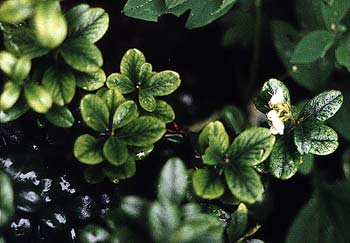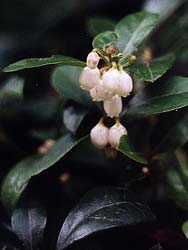
'Koralle' Lingonberry
"Long forgotten plants I know,
Where the best wild berries grow."
-Paul Laurence Dunbar
(1872-1906)
Lingonberries have accumulated an amazing assortment of common names including Lingon or Lingen, Linberry or Lingberry, Cowberry, Foxberry, Mountain Cranberry, Alpine Cranberry, Rock Cranberry, Bog Cranberry, Lowbush Cranberry, Shoreberry, Redberry, Red Bilberry, Red Whortleberry, Partridgeberry, Whimberry, & Windberry.(1872-1906)
Lingonberry provides one of the northern hemisphere's most important food crops, & has done so since Viking days, very likely since days of CroMagnon. Its natural range is just about the entire top of the planet in temperate & subarctic areas. Such a widespread & important vaccinium was bound to accumulate many names regionally, but the Scandinavian name "lingon" was adapted in the United States & Canada as "lingonberry," & has in recent decades become closest to a standard name.
 Previously the commonest name was Cowberry, especially in England, but this was regarded as being an unmarketable name. It is in Labrador & Newfoundland that they have been called Partridgeberries. In Nova Scotia they are Foxberries. The names Dry Ground Berry & Mossberry are usually restricted to an ultra-dwarf form, V. vitis-idaea var minus, native to New England, Canada & Alaska, by the Inuit called Kimminnait, or Airelle vigne-d'Idea in French Canada.
Previously the commonest name was Cowberry, especially in England, but this was regarded as being an unmarketable name. It is in Labrador & Newfoundland that they have been called Partridgeberries. In Nova Scotia they are Foxberries. The names Dry Ground Berry & Mossberry are usually restricted to an ultra-dwarf form, V. vitis-idaea var minus, native to New England, Canada & Alaska, by the Inuit called Kimminnait, or Airelle vigne-d'Idea in French Canada.Vaccinium vitis-idaea var majus is native to Europe & Asia all the way to Korea & Japan. An increasing array of common names can be found when non-English names are included, such as Tyttebaer in Norway; Rode Bosbessen or Vossenbessen in The Netherlands; Kuradimari, Paluk, Poolamari, Pohl, or Poolgad in Estonia; Lus nam Braoileag in Gaelic, Yue-ju in China, Kokemomo in Japan, Airelle Rouge in France, Mirtillo Rosso in Italy, Arandano Rojo in Spain; & so on. This little shrub's circumpolar distribution provides it a local name & usually multiple local names in each country or language of the upper portions of the northern hemisphere.
The first photo of a lingonberry bush was taken in July (2002), when it was one-foot tall & had been growing in rather deep shade for about a year. I planted a quarter-dozen lingberries near a basement window because they never get so tall as to block the little bit of reflected sunlight that reaches the sewing room in that corner of the basement. Three of these were 'Koralle' & the fourth was 'Red Pearl.'
If you look closely at the first 'Koralle' picture above, you can compare a previous year's darkest green evergreen leaves to the new year's veined & slightly lighter green growth. One of the scanty July rebloom flowers can also be seen; better blooms show on the second small portrait, taken in August (2002).
It is normal that lingonberries bloom twice a year, or even three times a year though the third flowering will be in September, too late for a third round of berries. They produce two berry crops a year. April/May flowers become ripe fruit for July/August. There will be fruits & flowers together in summer, & these will ripen in September/October. The summer harvest will be more tart than the autumn harvest; they're sweeter from the bush after a couple frosts.
Even though the shrubs remained attractively leafed in too little light, they did get a tad rangy searching for their share of sun, so when I moved some overbearing perennials, I also trimmed back the lingonberries so they would regain their compactness. Although they provided a pleasant evergreen groundcover doing quite well in shade, they do not fruit well unless they are in a good deal of sunlight. Our few plants blended into a large patch of Wintergreen shrublets which did produce plenty of winter berries in the shade corridor, but if the lingonberries were ever to be fruitful, I would have to move them, which I did in 2004.
When installing a large lingonberry patch at SinLur Gardens I selected a full-sun location in an organically rich moisture-retentive soil. I planted 'Koralle,' 'Red Pearl,' & 'Balsgard.' The moist sunny location for multiple cultivars insured maximum fruit production.
Nine of the bushes in this array were 'Koralle' which together in a group revealed 'Koralle' to be comparatively thin-branched, with less shininess & more of a mat finish to the leaves, & only moderately rhizomitous compared to 'Red Pearl' which suckers & colonizes more quickly. There can be some variation in cultivars labeled 'Koralle' from different growers, so they are sometimes designated the "Koralle Group." They tend to remain in the one-foot height compared to 'Red Pearl' which can reach sixteen inches, & they are mostly upright but not as strongly upright as 'Balsgard.'
In 1976 the Koralle Group received the Royal Botanical Society's Award of Garden Merit. 'Koralle' was developed in Germany. It produces copious numbers of striking shiny crayon-red berries. The mid-sized fruits are larger than 'Red Pearl' but smaller than 'Balsgard.'
Lingonberry was once regarded as medicinal. Midwives traditionally gave lingonberry juice to delivering mothers under the belief that this prevented hemorrhage & fever. The flowers were dried as a herbal remedy for lung ailments. Though medicinal claims are debatable or unproven, some of the healthful effects that have been proven of cranberries & blueberries do also apply to lingonberries which are similarly rich in healthful antioxidants & vitamins.